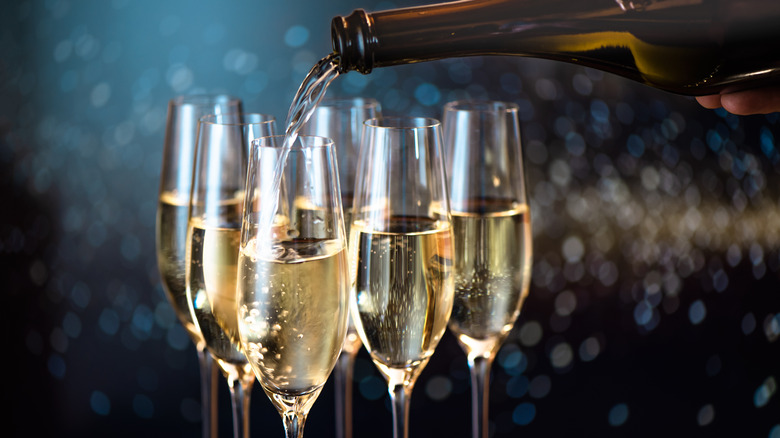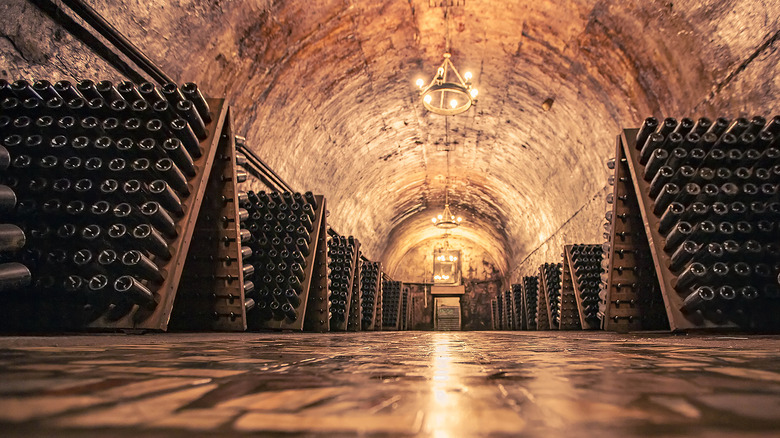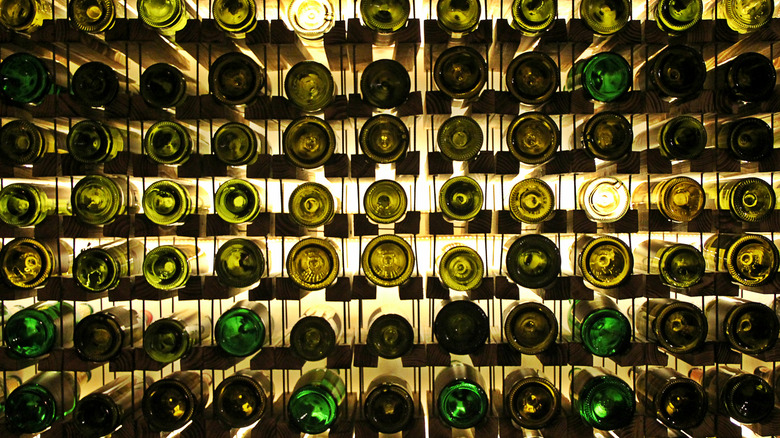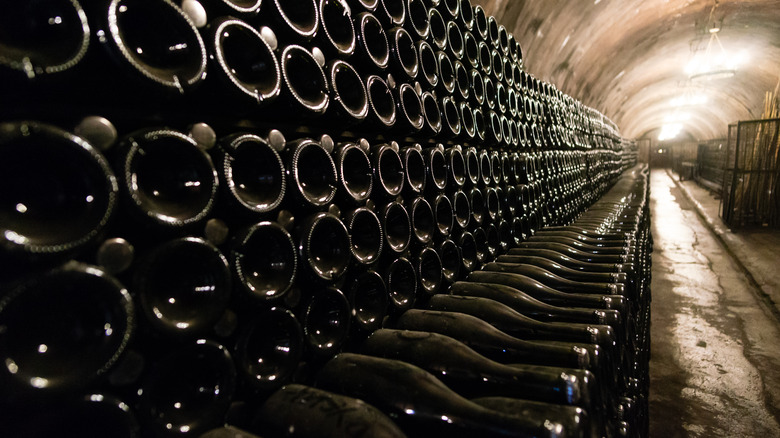The Absolute Best Ways To Store Champagne
In the Champagne region of France, subterranean caves have been dug in the chalky limestone beneath and around the vineyards and Maisons (known as the Champagne houses, via Decanter). These caves are perfect for storing and maturing Champagne because they offer the quietness and stillness that Champagne needs to thrive. The caves maintain the constant temperature and humidity needed for perfect bottle aging and protect against fluctuations brought on by drafts. Replicating these conditions is the goal when creating a space to store Champagne.
The luxury Champagne brand vendor Grandes Marques & Maisons de Champagne suggests that all Champagne is aged to perfection by each producer before it is released into the market for sale. In fact, France has a strict structure of laws in place to ensure this practice of aging before release (via Comité Champagne). Champagne is carefully monitored in the producer's cellar and released in optimal condition for fragrant aromas, lush flavors, and perfectly textured mousse. Champagne loses its luster over time, just like all wines. Only a small percentage of any given vintage of Champagne improves with further aging. The best quality level of the top brands will improve over time when stored impeccably.
According to Wine Spectator, Champagne should be stored in a cool, dark, still location, such as a wine cellar or a rarely used closet, because of its delicate nature. Just what is meant by cool, dark, and still? What additional storage factors impact the longevity of Champagne?
The angle of the bottle matters
According to Decanter, Champagne bottles can be stored upright for a month or two as long as the bottles are cool and undisturbed. Most wines that are intended for further aging and maturation in the bottle require they be positioned on their side to keep the corks moist. Grandes Marques & Maisons de Champagne indicates that every producer varies in their storage philosophy but suggests Champagne bottles have the advantage of containing an internal pressure due to the bubbles, which helps in preventing the corks from drying out.
Still, for longer storage and maturation in the bottle, store Champagne bottles on their sides just like the producers do in their underground wine cellars. As Didier Mariotti, a cellar master at Veuve Clicquot, explained to VinePair, doing so "keeps the cork from drying out and shrinking, which ultimately allows air to get in the bottle prior to even popping the cork."
Find a wine rack for your wine cellar that will accommodate the voluptuous shape of the Champagne bottle because most standard racks are made for a Bordeaux-style bottle that has straight, parallel sides.
Avoid light
Per the Champagne Collective, sparkling wines — from Champagne to Cava — are extremely sensitive to ultraviolet light, which damages the fizzy mousse and delicate aromas of the wine. The magazine explains that the use of darkly colored bottles is to shield the sparkling wine from light. Grandes Marques & Maisons de Champagne is critical of light in general, stating that conventional, fluorescent, and sunlight are highly damaging to Champagne, whereas sodium vapor lights, which are used in the Champagne caves across the Champagne region, have the least impact on the precious liquid inside the bottles.
For this reason, producers of high-end Champagne, wrap their prized bottles in branded tissue paper or foil before selling them. When storing Champagne, retain the tissue paper and if your bottles are not wrapped, consider wrapping them before you store them in a dark closet or wine cellar, via Food52. If you collect several brands, use colored tissue paper that matches the brand label to distinguish one from another.
Consistent temperature and humidity
Champagne likes a consistent and stable environment. That includes keeping the bottles at a constant temperature and humidity level. Comité Champagne says two of the three "golden rules" of proper Champagne storage are low, ambient temperature and generous humidity.
Per Wine Spectator, it's OK to use a cooling unit or a wine refrigerator specifically designated for Champagne to store bottles in the short term (Vino Vest says three to four days). However, wine refrigerators aren't ideal for long-term storage of high-end wine or Champagne due to micro vibrations and bursts of light each time the door is opened.
Instead, for longer storage, store your sparkling wines in a wine cellar or the coldest closet in your house. The optimal temperature range for Champagne, per Decanter, is between 45 degrees and 50 degrees Fahrenheit with controlled humidity. G.H. Mumm suggests humidity in the 60 to 70 F range. Few houses maintain this level of humidity, though, so look for a low-maintenance humidifier to augment the environment around your Champagne.
Also, consider storing Champagne separate from still wines, which require different storage environments, including temperature.
Sound, vibration, drafts, and odors
Aside from ultraviolet light, temperature, and humidity fluctuations, perhaps the greatest threats to delicate Champagne flavors and the fizzy mousse are vibration, sound, odors, and drafts. Drafts in the storage area or cellar defeat the consistency in temperature and humidity that is necessary to maintain the quality of the stored Champagne.
Wine Spectator indicates even micro-vibration can be damaging to the constitution and texture of Champagne. Vibration can be a result of nearby electronic devices, appliances, and sounds. Keep your stored Champagne away from electronics and appliances, including phones, radios, TVs, refrigerators, heaters, and computers. Grandes Marques & Maisons de Champagne mentions odors can be harmful when storing Champagne because they can permeate the porous corks used to stopper the wine. Even though most corks are wrapped in foil, plastic, or wax, pungent odors like garlic, spice, perfume, cosmetics, automobile fumes, and smoke can seep in little by little, tainting the subtle flavors of the sparkling wine.
No matter how Champagne is stored, though, it has a definitive life cycle; it won't last forever. Decanter says that magnums, because of their larger size, have an ideal wine-to-the-surface ratio that enhances long-term maturation in the bottle, for up to 20 to 30 years. Note that regular bottles contain 750 milliliters of wine whereas magnums contain 1,500 milliliters.
No matter the size of the Champagne bottle you collect, however, store it correctly in the proper conditions and check on it often to ensure it lasts until you are ready to pop the cork.




